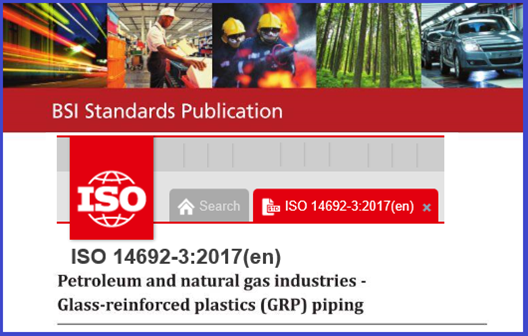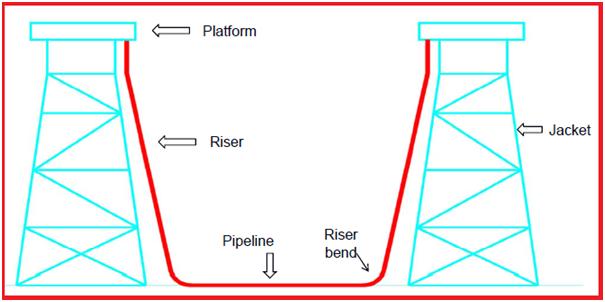What is ISO 14692?
ISO 14692 is an international standard that specifies the requirements and recommendations for the design, construction, installation, and operation of fiberglass-reinforced plastic (FRP) piping systems in offshore and onshore oil and gas production, as well as other corrosive environments. The standard covers the use of FRP piping systems for both aboveground and belowground applications, including buried and submerged pipelines.
ISO 14692 provides guidelines for the selection of materials, design considerations, manufacturing, testing, installation, and maintenance of FRP piping systems. It also includes requirements for quality control, inspection, and certification of FRP piping systems.
The standard was developed by the International Organization for Standardization (ISO) Technical Committee TC 138, which is responsible for developing standards related to plastic pipes and fittings for non-pressure applications. ISO 14692 is intended to provide a standardized approach to the design and construction of FRP piping systems, ensuring safe and reliable operation in harsh environments such as those encountered in the oil and gas industry.
Significance of ISO 14692
ISO 14692 is significant for several reasons:
- Safety: The standard provides guidelines for the safe design, construction, installation, and operation of fiberglass-reinforced plastic (FRP) piping systems in corrosive environments, such as those encountered in the oil and gas industry. By adhering to the standard, companies can ensure that their piping systems are designed to be safe and reliable, reducing the risk of accidents or failures that could lead to injury, environmental damage, or financial losses.
- Quality: ISO 14692 provides requirements for quality control, inspection, and certification of FRP piping systems. By following these requirements, companies can ensure that their piping systems meet the necessary quality standards, reducing the risk of defects or failures that could compromise the integrity of the system.
- Cost-effective: FRP piping systems are often more cost-effective than traditional materials such as steel or concrete, particularly in corrosive environments. By using ISO 14692 as a guide, companies can ensure that they are selecting the most appropriate materials and designs for their specific application, optimizing the cost-effectiveness of the system.
- International recognition: ISO 14692 is an international standard that is recognized by organizations and companies around the world. By following the standard, companies can ensure that their FRP piping systems meet the same requirements as those used by their counterparts in other countries, facilitating international trade and collaboration.
Overall, ISO 14692 is significant because it provides a standardized approach to the design and construction of FRP piping systems, ensuring safe and reliable operation in harsh and corrosive environments. By following the standard, companies can reduce the risk of accidents or failures, ensure quality, optimize cost-effectiveness, and facilitate international trade and collaboration.
What’s New in ISO 14692-2017
In the year 2017, a renewed edition of the ISO-14692, the governing standard for fiber-reinforced plastic piping, was officially released. There are many significant changes with respect to the earlier edition. For example, there are changes in the regression gradient for qualification, the maximum pressure rating terminology, the stress intensification, stress envelope definition, the scaling rules for qualified components, buried pipe assessment, fatigue method, test methods for flanges, etc. All these changes can be studied in detail from the latest code. This article will try to explain a few of the important points in brief.
The objective of ISO 14692 is to provide the oil and gas industry, as well as the supporting engineering and manufacturing industry, with mutually agreed specifications and recommended practices for the purchase, qualification, manufacturing, design, handling, storage, installation, commissioning, and operation of GRP piping systems.
The previous official release of the code was in the year 2002. Since then the experience with FRP piping has increased significantly, and much of this experience is now included in this latest revision of the standard. Issue 2017 of the standard now contains more background to design requirements and provides more clearly defines a step-by-step set of guidelines. The standard offers a questionnaire to be filled out by the end user in the bidding stage. This questionnaire aids the end-user to provide the right information to the manufacturer and designer. Information such as pressure and temperature requirements as well as other information crucial to select the appropriate FRP piping component composition as pressure class. By providing clearer requirements for the provision of information, there is a much higher chance that all selection and design of the FRP system occurs, and conforms to the standard requirements.

Contrary to the last official release of the standard in the year 2002, the new edition addresses buried GRP piping. A pipe buried in soil with a certain cover depth will experience a vertical deflection due to the weight of the soil and additional soil loads. Previously, to assess such deflection, the engineer would need to divert to the rules and guidelines of the AWWA M45 standard. Since this assessment is already standard practice by many engineers in the design of buried piping, the AWWA M45 vertical deflection assessment was brought into the ISO-14692, thus making this a mandatory component of the assessment of buried piping when following the ISO 14692.
One aspect of the standard that did not match industry common practices has been the application of the stress intensification factors (SIF’s) and flexibility factors. Much of the original research on these values was done in the context of stress analysis of components made of anisotropic materials. The design of anisotropic components generally differs considerably from that of isotropic materials. The 2002 edition of the standard provided SIFs for fiberglass fittings which were based on the SIFs in the BS7159. A study performed by SINTEF has shown that the BS7159 underpredicts the stiffness of GRP fittings substantially, from which it can be concluded that the SIFs from the BS7159 is not applicable to GRP fittings. Therefore one common practice in the industry was to use a SIF of 2.3 in combination with modeling the true reinforced wall thickness of the applicable fitting. This modeling approach was based on the experience of the industry rather than the ISO14692 philosophy as presented in the 2002 edition of the standard.
The 2017 edition of the standard provides a new modeling approach to be used for pipe stress and flexibility analyses which are based on using a standard SIF of 1.5 in combination with an equivalent fitting thickness. The latest revision also provides a standard for the qualification of the SIF. Thereby a manufacturer also has the possibility of taking credit for a potentially lower SIF than 1.5 for a specific elbow design. Other important features of ISO 14692 have undergone very significant changes as well, such features are the qualification of GRP piping components, the standard on GRP flanges, the design stress envelope, fatigue in GRP, and static electricity.
Few more related articles for you.
Stress Analysis of GRP / GRE / FRP piping system using Caesar II
Overview of GRP Pipes
An Article on HYDROSTATIC FIELD TEST of GRP / GRE lines
Buried GRP/FRP pipe Laying and Installation Procedure









Very Good Initiatives Anup, My wishes